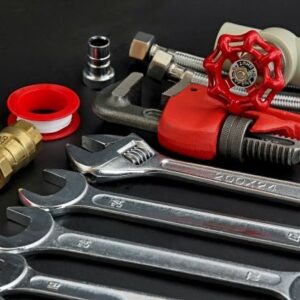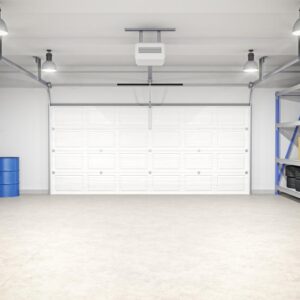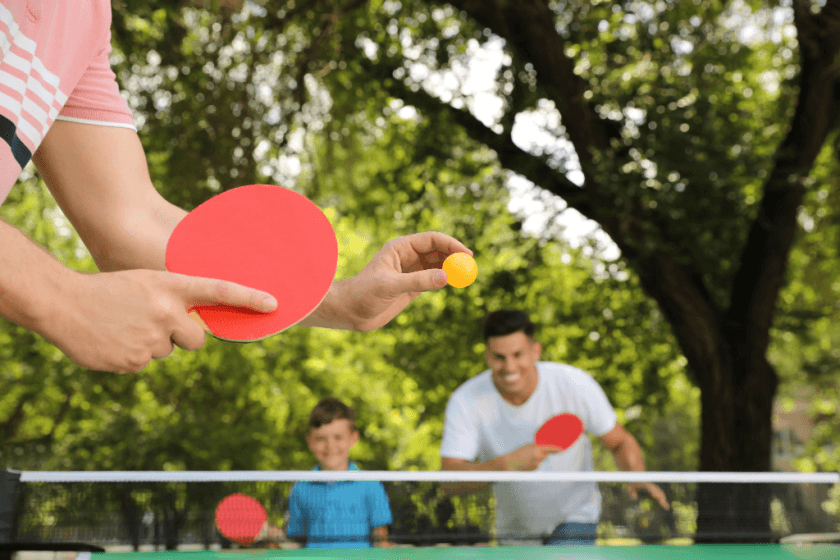Table tennis, or ping pong as many call it, is the perfect game for social gatherings. It’s easy for people of all ages to play, and it’s a great bonding activity. However, ping pong tables are big, which means it’s challenging to find a place for them. If you have a backyard, consider making your own convertible ping pong dining table. After using the table for an outdoor meal, you can quickly convert it to handle an evening of ping pong.
Can Ping Pong Tables Be Outside?
Ping pong tables can be outside as long as you purchase the right kind of wood and seal it. Some woods can withstand the elements without requiring you to seal them, but they’ll fade over time from UV exposure and adverse weather.
If you intend to make an outdoor convertible ping pong table, consider putting it under an awning or veranda that helps block the elements. Some types of wood require more protection than others.
What Are Outdoor Ping Pong Tables Made of?
The best wood options for outdoor furniture like convertible ping pong tables are:
- Acacia
- Black locust
- Cypress
- Cedar
- Redwood
When selecting wood for an outdoor ping pong table that doubles as a dining table, consider aesthetics. The great thing about wood is that the material is timeless. People have been making outdoor features from wood for centuries. It’s also a diverse material that comes in a variety of colors, textures, and hardness levels.
Acacia
Acacia is affordable and durable, but if you place an acacia ping pong table on wet ground, it may rot. If you decide to use acacia wood, then be sure to place the table on a cement patio or deck. You’ll also want to seal it annually with a clear protective coat like a lumber sealant.
Black Locust
Black locust wood is an extremely durable hardwood. While it takes more effort to cut, this kind of hardwood can withstand extreme weather conditions. It also holds up against fungus and insect infestations. You don’t have to stain black locust. However, the wood type will fade.
Cypress
Cypress is easy to work with, making it an excellent choice for a multi-purpose ping pong table. Many DIYers love cypress because it features a lovely golden brown to reddish-brown hue. It’s also resistant to rain, warping, pests, and rot. Cypress features a natural oil called cypressane that preserves it. If you decide to make your table from cypress, avoid over-sanding it.
Cedar
Cedar is a beautiful wood, one that fades into an attractive brown shade. Cedar is a straight grain wood, but some cedar sections feature a knotty look. The wood is lightweight and soft. You’ll love sawing cedar because it emits a pleasant smell when you cut it. This wood type naturally resists rot, moisture, and insects.
Redwood
Redwood will give your table a vibrant look, but it may cost more than the other woods because of supply issues. Redwood features a light pink to deep red hue, and it has a straight to asymmetrical grain. These elements make it a wonderful choice for outdoor furniture. Redwood resists shrinking and warping in hot or moist conditions. It also resists rotting and insects.
How Thick Should an Outdoor Ping Pong Table Be?
Make your outdoor do-it-yourself ping pong table about 1.5 inches thick and 60 inches wide. Build your table to be about 108 inches long.
How Do You Make an Outdoor Ping Pong Table?
To make your own outdoor ping pong table that can also be used for dining, be sure to collect the proper materials. You’ll also need to be comfortable using equipment like saws, planes, and drills. Here are the DIY steps.
Step 1: Gather the Materials
Before you start building, make sure that you have everything that you’ll need. Gather the following materials:
- Wood
- Wood sealer
- Primer
- Wood glue
- Screws
- Material for the net
Here’s a list of the equipment you’ll likely need:
- Table saw
- Cordless drill
- Sander
- Plane
- Joiner
Step 2: Cut the Wood
Once you have the materials and equipment that you need, cut your wood to size. You’ll need to cut the tabletop, the legs, and the support boards. Use the joiner to make the top of the table level. This is important when you’re using the surface to play ping pong. If you don’t have a joiner, your local lumber provider can probably mill the tabletop for you.
Be sure to cut a long support board that measures about 8 feet and a short one that measures around 56 inches. You’ll also need trim for the table. Make sure you have a piece that’s long enough for the short side and one that provides trim for the long side of the table.
Step 2: Glue the Supports and Add the Trim
The next step is to glue the supports. Position the short support boards about 2.5 inches up the tabletop base. Then, glue them in place. Add screws for additional support. Once the short boards are in place, you’ll be ready to connect the long support boards. Attach the long ones between the short boards.
After the support pieces are in place, add the trim. You can use a nail gun for this step.
Step 3: Make the Ping Pong Table Lines
To make the ping pong table lines, use painter’s tape. Attach it around the top of the board. Stain the table in your favorite shade. Once the stain is dry, remove the tape to reveal the gaming lines.
Measure out the center section of the table’s long sides. Mark the center using a pencil. Drill a hole at the center point. Install dowels on each side of the table to connect the net.
Regardless of the material that you decide to use for the net, make sure that it features a strong hem. That way, you’ll be able to tighten the net down. A convenient option is to drill a hole along the side of the table and install a hook where you can hang a bag to hold your ping pong playing equipment.
Step 4: Mount the Legs
Mount the legs to the bottom of the table. Consider depressing the bases to avoid sharp edges. This step will prevent people from hurting themselves on the table legs when they are engaged in gameplay.
One of the best ways to mount legs is to tap holes right into the wood. Mark the location for each hole and then center punch them. When doing this, be sure to mark the depth to avoid drilling into the top of the table. You can use painter’s tape to mark the depth. After tapping the holes for the ping pong dining table combo, use bolts to connect the table legs. Now, you’re ready to attach and use the net when you’re ready for a game.
DIY Your Own Outdoor Dining Table that Converts Into a Ping Pong Table
A DIY ping pong table that converts into a dining table is the perfect project, one that will give your family an activity to enjoy and a place to eat dinner outside. When you take the time to build your own furniture, it’s sure to increase your confidence and save money. To purchase the supplies that you need for the project, visit a True Value store. Use our store finder to find a True Value near you.












